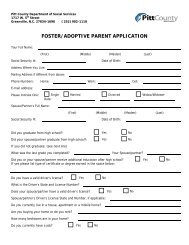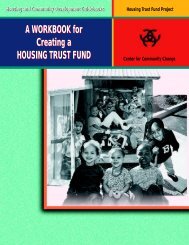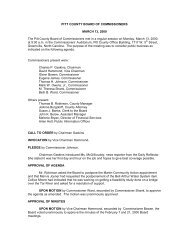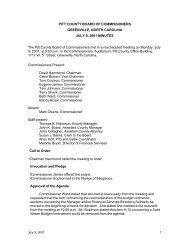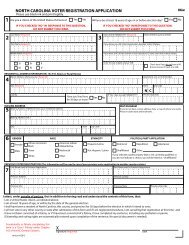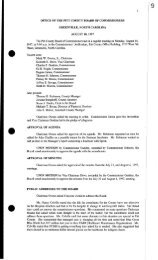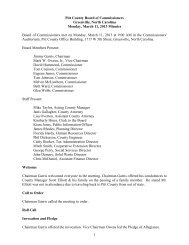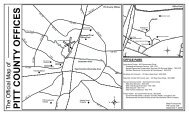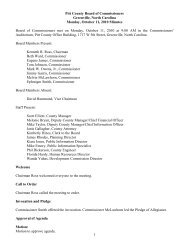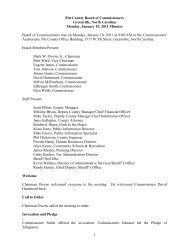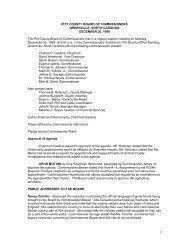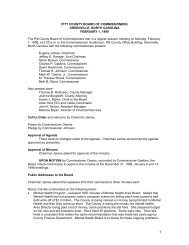2030 Comprehensive Land Use Plan - Pitt County Government
2030 Comprehensive Land Use Plan - Pitt County Government
2030 Comprehensive Land Use Plan - Pitt County Government
- No tags were found...
Create successful ePaper yourself
Turn your PDF publications into a flip-book with our unique Google optimized e-Paper software.
Table A-9Farm Operators by Principal Occupation – 1987, 1992, 1997, 2002, and 2007Primary Occupation 1987 1992 1997 2002 2007Farming 536 388 318 301 262Other Occupation 221 195 156 147 173Source: North Carolina Department of Agriculture and Consumer Services.Tobacco ProductionSince the 1930s, federal tobacco quota and price support programs had kept prices artificiallyhigh in the United States by limiting how much tobacco could be grown. In 2004, the Fair andEquitable Tobacco Reform Act was signed into law and eliminated federal farm price supportfor tobacco at the end of the 2004 crop year. Beginning in the 2005 crop year, there were nolonger any restrictions on the number of farmers that could grow and market tobacco, wheretobacco could be grown, or the amount that could be grown and marketed.The Reform Act also established the Tobacco Transition Payment Program, otherwise knownas the “tobacco buyout”. As part of the buyout, approximately $9.6 billion in compensatorypayments are being paid to tobacco quota owners and active producers over a period of 10years to compensate for lost rents and to aid in the transition to a free market. It is estimatedthat the State of North Carolina will receive nearly $4 billion dollars in quota buyout paymentsby the year 2014, and <strong>Pitt</strong> <strong>County</strong> will receive approximately $220 million. Money to pay forthe buyout comes from assessments on tobacco products manufacturers and importers.Prior to the buyout, analysts anticipated that tobacco production would be consolidated ontolarger, but substantially fewer, farms located in the most economical regions. Total U.S.tobacco production was expected to increase, however it declined almost 37% in 2005 and hasfluctuated since then. Prior to 2005, <strong>Pitt</strong> <strong>County</strong> typically ranked #1 or #2 in tobaccoproduction in the State. Since the buyout, tobacco production has steadily decreased in the<strong>County</strong>, and in 2010, <strong>Pitt</strong> <strong>County</strong> ranked #11 in tobacco production in the State. In 2000, the<strong>County</strong> produced over 22 million pounds of tobacco on 9,200 acres of farmland. A decadelater, in 2010, production decreased to 13 million pounds on just 6,000 acres – a 41% decline inproduction and a 35% decline in farmland.The economics of tobacco production since 2005 have caused smaller farms to either transitionaway from tobacco to more profitable field crops or to discontinue farming altogether. Thishas increased the supply of farm land available for development in the <strong>County</strong>. As land usedevelopment occurs, farming in general should be protected as an essential component of thelocal economy. To do that, growth must follow a logical and sequential pattern to ensure thatthe agricultural community can continue to operate efficiently until growth reaches particularareas of the <strong>County</strong>.<strong>2030</strong> <strong>Comprehensive</strong> <strong>Land</strong> <strong>Use</strong> <strong>Plan</strong> Appendix A: Inventory and Analysis<strong>Pitt</strong> <strong>County</strong>, North Carolina A-20



